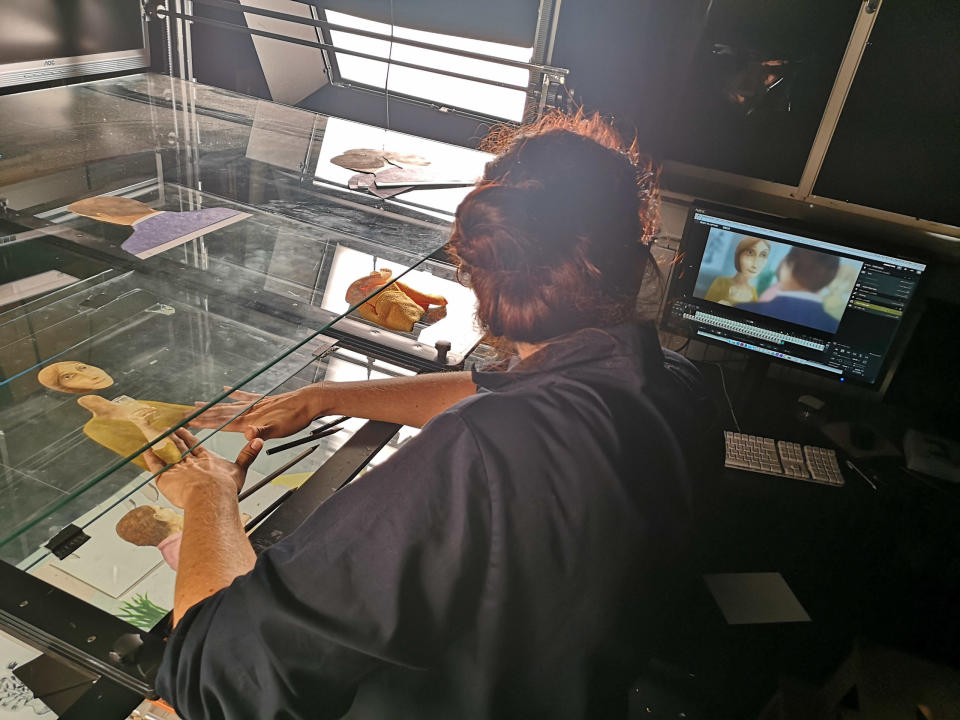‘Steakhouse’ Uses a Classic Disney Animation Technique to Serve Up Meaty Domestic Drama

A meaty domestic drama with a deliciously dark twist, animated short film “Steakhouse” offers a tableside view of what Slovenian filmmaker Špela Čadež calls “psychological violence.”
The 10-minute short, which has garnered more than 30 awards on its 150-plus-festival run and was recently shortlisted for an Oscar, uses smart cinematic storytelling to unspool the story of married couple Franc and Liza.
More from IndieWire
Liza, detained at work, anxiously hurries home for a special birthday dinner that has been timed to her exact arrival. Increasingly frenzied jazz (by Slovenian experimental lo-fi musician Andrej Fon’s Olfamož) floods the kitchen as Franc’s meticulous preparations boil over into rage at Liza’s tardiness. Spitefully ruining the meal, Franc fills their small apartment with billowing clouds of toxicity, then forces Liza to witness his violent mastication—rendered in hideous closeup — but his maliciousness proves to be his own undoing. No spoilers here, but the ending lands on a nasty final course that is oddly soothing and entirely earned.
The Slovenian-French-German co-production is the follow-up to “Nighthawk,” Čadež’s masterful 2016 short featuring a drunken badger careening recklessly on the highway behind the wheel of an automobile. Both films employ multiplane animation, a painstaking technique developed at Walt Disney Studios that moves elements placed in layers past a camera to create an illusion of depth.
“What I love about the technique is that it offers so many coincidences,” Čadež told IndieWire. “For me, it’s always a playground of lights and shadow and materials. Sometimes you put something in between and it just works, or [provides] some, I don’t know, playfulness with illusion. I really love the technique. I think it has a lot to offer. And most of all, we love working in it.”

The visuals of “Steakhouse,” Čadež revealed, were partially inspired by the semi-pornographic tropes of popular cooking shows. “What struck me was the way that they were filming this act of cooking, because it was so brutally aggressive with the way the camera was set up so it was almost in the middle of a hot pan. It was so close to the steak. And those extreme closeups, they were more than just cooking,” she said, explaining how these shows tend to fetishize the power of the chef with their dynamic energy and intimate camera placement.
The cut-out characters and billowing clouds of smoke in “Steakhouse” take inspiration from Russian animator Yuri Norstein’s beloved 1975 short “Hedgehog in the Fog,” which also employed a multiplane camera. Countless numbers of elements were painted and cut out by hand to create each frame of animation, often in real time.
“We were trying to pre-prepare things, but it’s actually very difficult to do because when you put the things under the camera in the multiplane, sometimes things that are beautifully drawn are just not working well and you have to make them completely different, or maybe the colors aren’t working,” Čadež said, recalling how the small team of four animators would often paint directly under the camera. “Especially the lights and the shadows,” she added.
“It’s almost like painting a canvas,” Čadež said, describing how sometimes just the random placement of a piece of colored paper could provide an unexpectedly beautiful result. “You can do some things before, especially for those exchangeable parts. We could pre-animate them in computer, print them out, and then color them. But still, you have to test if the color is working, if the shades are okay, if they’re not too jumpy. So, it was a lot of testing before the final shot.”
Čadež has a fascination with difficult subjects, fueled in part by her tumultuous childhood; her films delve into painful, often hidden subjects such as alcoholism and domestic abuse. “Steakhouse,” she said, “invades” Franc and Liza’s privacy, uncovering what are normally hidden domestic moments. “My parents would fight a lot and I remember this feeling of wanting to disappear from that place and feeling helpless in that situation. But being there, with the camera just as an observer, is something that film now allows me to do.”
The script for “Steakhouse” was written by Čadež’s partner, Gregor Zorc, who also co-wrote the script for “Nighthawk.” “He’s always trying to persuade me to go as far away as possible from cliches,” Čadež said of their collaboration, sharing how he urged her to avoid creating “a character that you can see from 1,000 meters that he’s abusive.”
She added, “Actually, people who don’t look like that can be that way. And that is way more interesting to find characters who are not really showing that, but are suffering through that.”
The film’s delectable ending, Čadež said, was conceived from the very beginning. “Usually we are searching for the ending when we are writing stories, but here the end was already so strong that everything else would just need to lead there,” she said. “I remember the moment when he told me this story in five minutes, and showing me the end, but then we needed almost three years to make the film. So, yeah, that’s the beauty of animation.”
“Steakhouse” is now streaming at shortoftheweek.com and on the Short of the Week YouTube channel.
Best of IndieWire
Sign up for Indiewire's Newsletter. For the latest news, follow us on Facebook, Twitter, and Instagram.

